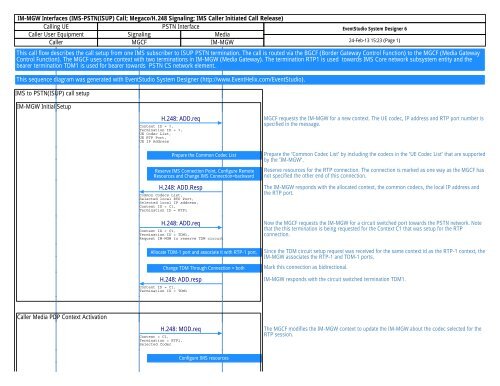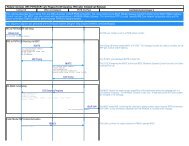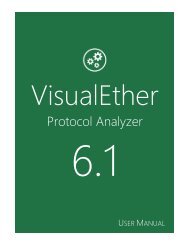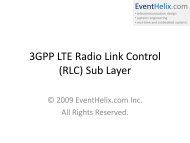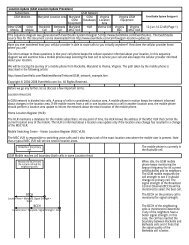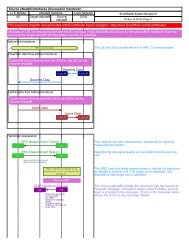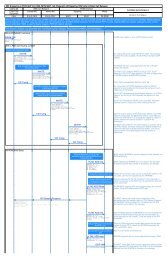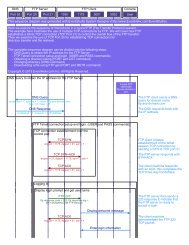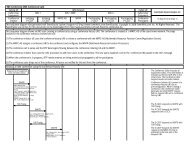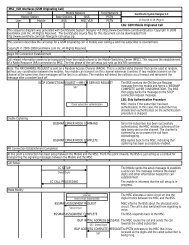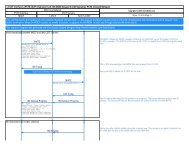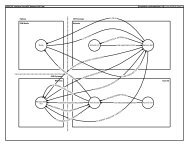IM-MGW Call Flow - EventHelix.com
IM-MGW Call Flow - EventHelix.com
IM-MGW Call Flow - EventHelix.com
You also want an ePaper? Increase the reach of your titles
YUMPU automatically turns print PDFs into web optimized ePapers that Google loves.
<strong>IM</strong>-<strong>MGW</strong> Interfaces (<strong>IM</strong>S-PSTN(ISUP) <strong>Call</strong>; Megaco/H.248 Signaling; <strong>IM</strong>S <strong>Call</strong>er Initiated <strong>Call</strong> Release)<br />
<strong>Call</strong>ing UE<br />
PSTN Interface<br />
<strong>Call</strong>er User Equipment Signaling Media<br />
<strong>Call</strong>er MGCF <strong>IM</strong>-<strong>MGW</strong><br />
EventStudio System Designer 6<br />
24-Feb-13 15:23 (Page 1)<br />
This call flow describes the call setup from one <strong>IM</strong>S subscriber to ISUP PSTN termination. The call is routed via the BGCF (Border Gateway Control Function) to the MGCF (Media Gateway<br />
Control Function). The MGCF uses one context with two terminations in <strong>IM</strong>-<strong>MGW</strong> (Media Gateway). The termination RTP1 is used towards <strong>IM</strong>S Core network subsystem entity and the<br />
bearer termination TDM1 is used for bearer towards PSTN CS network element.<br />
This sequence diagram was generated with EventStudio System Designer (http://www.<strong>EventHelix</strong>.<strong>com</strong>/EventStudio).<br />
<strong>IM</strong>S to PSTN(ISUP) call setup<br />
<strong>IM</strong>-<strong>MGW</strong> Initial Setup<br />
H.248: ADD.req<br />
Context ID = ?,<br />
Termination ID = ?,<br />
UE Codec List,<br />
UE RTP Port,<br />
UE IP Address<br />
Prepare the Common Codec List<br />
Reserve <strong>IM</strong>S Connection Point, Configure Remote<br />
Resources and Change <strong>IM</strong>S Connection=backward<br />
H.248: ADD.Resp<br />
Common Codecs List,<br />
Selected local RTP Port,<br />
Selected local IP address,<br />
Context ID = C1,<br />
Termination ID = RTP1<br />
H.248: ADD.req<br />
Context ID = C1,<br />
Termination ID = TDM1,<br />
Request <strong>IM</strong>-<strong>MGW</strong> to reserve TDM circuit<br />
Allocate TDM-1 port and associate it with RTP-1 port.<br />
Change TDM Through Connection = both<br />
H.248: ADD.resp<br />
Context ID = C1,<br />
Termination ID = TDM1<br />
MGCF requests the <strong>IM</strong>-<strong>MGW</strong> for a new context. The UE codec, IP address and RTP port number is<br />
specified in the message.<br />
Prepare the "Common Codec List" by including the codecs in the "UE Codec List" that are supported<br />
by the "<strong>IM</strong>-<strong>MGW</strong>".<br />
Reserve resources for the RTP connection. The connection is marked as one way as the MGCF has<br />
not specified the other end of this connection.<br />
The <strong>IM</strong>-<strong>MGW</strong> responds with the allocated context, the <strong>com</strong>mon codecs, the local IP address and<br />
the RTP port.<br />
Now the MGCF requests the <strong>IM</strong>-<strong>MGW</strong> for a circuit switched port towards the PSTN network. Note<br />
that the this termination is being requested for the Context C1 that was setup for the RTP<br />
connection.<br />
Since the TDM circuit setup request was received for the same context id as the RTP-1 context, the<br />
<strong>IM</strong>-<strong>MGW</strong> associates the RTP-1 and TDM-1 ports.<br />
Mark this connection as bidirectional.<br />
<strong>IM</strong>-<strong>MGW</strong> responds with the circuit switched termination TDM1.<br />
<strong>Call</strong>er Media PDP Context Activation<br />
H.248: MOD.req<br />
Context = C1,<br />
Termination = RTP1,<br />
Selected Codec<br />
The MGCF modifies the <strong>IM</strong>-<strong>MGW</strong> context to update the <strong>IM</strong>-<strong>MGW</strong> about the codec selected for the<br />
RTP session.<br />
Configure <strong>IM</strong>S resources
<strong>IM</strong>-<strong>MGW</strong> Interfaces (<strong>IM</strong>S-PSTN(ISUP) <strong>Call</strong>; Megaco/H.248 Signaling; <strong>IM</strong>S <strong>Call</strong>er Initiated <strong>Call</strong> Release)<br />
<strong>Call</strong>ing UE<br />
PSTN Interface<br />
<strong>Call</strong>er User Equipment Signaling Media<br />
<strong>Call</strong>er MGCF <strong>IM</strong>-<strong>MGW</strong><br />
H.248: MOD.resp<br />
Context = C1,<br />
Termination = RTP1<br />
<strong>IM</strong>-<strong>MGW</strong> responds back.<br />
EventStudio System Designer 6<br />
24-Feb-13 15:23 (Page 2)<br />
Ringing<br />
RTP: Ring Back Tone<br />
Ring Back Tone The ring back tone is fed to the calling subscriber. The <strong>IM</strong>-<strong>MGW</strong> converts the tone into RTP. The<br />
UE converts it back to the ring back tone and feeds it to the calling subscriber.<br />
Conversation Mode<br />
H.248: MOD.req<br />
Context ID = C1,<br />
Termination ID = RTP1<br />
Request a bidirectional through connection<br />
Change <strong>IM</strong>S Through Connection = both<br />
H.248: MOD.resp<br />
Context ID = C1,<br />
Termination ID = RTP1<br />
H.248: MOD.req<br />
Context ID = C1,<br />
Termination ID = TDM1<br />
Request activation of TDM voice processing function.<br />
Activate TDM Voice Processing Function<br />
H.248: MOD.resp<br />
Context ID = C1,<br />
Termination ID = TDM1<br />
RTP: Voice<br />
H.248: SUB.req<br />
Context ID = C1,<br />
Termination ID = RTP1<br />
H.248: SUB.resp<br />
Context ID = C1,<br />
Termination ID = RTP1<br />
Voice<br />
Bidirectional voice path is now through. The <strong>IM</strong>-<strong>MGW</strong> converts RTP to voice and vice versa. UE<br />
also maps audio to RTP and back.
<strong>IM</strong>-<strong>MGW</strong> Interfaces (<strong>IM</strong>S-PSTN(ISUP) <strong>Call</strong>; Megaco/H.248 Signaling; <strong>IM</strong>S <strong>Call</strong>er Initiated <strong>Call</strong> Release)<br />
<strong>Call</strong>ing UE<br />
PSTN Interface<br />
<strong>Call</strong>er User Equipment Signaling Media<br />
<strong>Call</strong>er MGCF <strong>IM</strong>-<strong>MGW</strong><br />
H.248: SUB.req<br />
Context ID = C1,<br />
Termination ID = TDM1<br />
EventStudio System Designer 6<br />
24-Feb-13 15:23 (Page 3)<br />
H.248: SUB.resp<br />
Context ID = C1,<br />
Termination ID = TDM1<br />
This sequence diagram was generated with EventStudio System Designer (http://www.<strong>EventHelix</strong>.<strong>com</strong>/EventStudio).
<strong>IM</strong>-<strong>MGW</strong> Interfaces (<strong>Call</strong>ed PSTN Subscriber Initiates Release)<br />
<strong>Call</strong>ing UE<br />
PSTN Interface<br />
<strong>Call</strong>er User Equipment Signaling Media<br />
<strong>Call</strong>er MGCF <strong>IM</strong>-<strong>MGW</strong><br />
EventStudio System Designer 6<br />
24-Feb-13 15:23 (Page 4)<br />
This call flow describes the call setup from one <strong>IM</strong>S subscriber to ISUP PSTN termination. The call is routed via the BGCF (Border Gateway Control Function) to the MGCF (Media Gateway<br />
Control Function). The MGCF uses one context with two terminations in <strong>IM</strong>-<strong>MGW</strong> (Media Gateway). The termination RTP1 is used towards <strong>IM</strong>S Core network subsystem entity and the<br />
bearer termination TDM1 is used for bearer towards PSTN CS network element.<br />
This sequence diagram was generated with EventStudio System Designer (http://www.<strong>EventHelix</strong>.<strong>com</strong>/EventStudio).<br />
<strong>IM</strong>S to PSTN(ISUP) call setup<br />
RTP: Voice<br />
H.248: SUB.req<br />
Context ID = C1,<br />
Termination ID = RTP1<br />
H.248: SUB.resp<br />
Context ID = C1,<br />
Termination ID = RTP1<br />
H.248: SUB.req<br />
Context ID = C1,<br />
Termination ID = TDM1<br />
H.248: SUB.resp<br />
Context ID = C1,<br />
Termination ID = TDM1<br />
Voice<br />
Bidirectional voice path is now through. The <strong>IM</strong>-<strong>MGW</strong> converts RTP to voice and vice versa. UE<br />
also maps audio to RTP and back.<br />
This sequence diagram was generated with EventStudio System Designer (http://www.<strong>EventHelix</strong>.<strong>com</strong>/EventStudio).
<strong>IM</strong>-<strong>MGW</strong> Interfaces (<strong>IM</strong>S Network Initiates <strong>Call</strong> Release)<br />
<strong>Call</strong>ing UE<br />
PSTN Interface<br />
<strong>Call</strong>er User Equipment Signaling Media<br />
<strong>Call</strong>er MGCF <strong>IM</strong>-<strong>MGW</strong><br />
EventStudio System Designer 6<br />
24-Feb-13 15:23 (Page 5)<br />
This call flow describes the call setup from one <strong>IM</strong>S subscriber to ISUP PSTN termination. The call is routed via the BGCF (Border Gateway Control Function) to the MGCF (Media Gateway<br />
Control Function). The MGCF uses one context with two terminations in <strong>IM</strong>-<strong>MGW</strong> (Media Gateway). The termination RTP1 is used towards <strong>IM</strong>S Core network subsystem entity and the<br />
bearer termination TDM1 is used for bearer towards PSTN CS network element.<br />
This sequence diagram was generated with EventStudio System Designer (http://www.<strong>EventHelix</strong>.<strong>com</strong>/EventStudio).<br />
<strong>IM</strong>S to PSTN(ISUP) call setup<br />
RTP: Voice<br />
H.248: SUB.req<br />
Context ID = C1,<br />
Termination ID = RTP1<br />
H.248: SUB.resp<br />
Context ID = C1,<br />
Termination ID = RTP1<br />
H.248: SUB.req<br />
Context ID = C1,<br />
Termination ID = TDM1<br />
H.248: SUB.resp<br />
Context ID = C1,<br />
Termination ID = TDM1<br />
Voice<br />
Bidirectional voice path is now through. The <strong>IM</strong>-<strong>MGW</strong> converts RTP to voice and vice versa. UE<br />
also maps audio to RTP and back.<br />
This sequence diagram was generated with EventStudio System Designer (http://www.<strong>EventHelix</strong>.<strong>com</strong>/EventStudio).
<strong>IM</strong>-<strong>MGW</strong> Interfaces (MGCF Initiated <strong>Call</strong> Release)<br />
<strong>Call</strong>ing UE<br />
PSTN Interface<br />
<strong>Call</strong>er User Equipment Signaling Media<br />
<strong>Call</strong>er MGCF <strong>IM</strong>-<strong>MGW</strong><br />
EventStudio System Designer 6<br />
24-Feb-13 15:23 (Page 6)<br />
This call flow describes the call setup from one <strong>IM</strong>S subscriber to ISUP PSTN termination. The call is routed via the BGCF (Border Gateway Control Function) to the MGCF (Media Gateway<br />
Control Function). The MGCF uses one context with two terminations in <strong>IM</strong>-<strong>MGW</strong> (Media Gateway). The termination RTP1 is used towards <strong>IM</strong>S Core network subsystem entity and the<br />
bearer termination TDM1 is used for bearer towards PSTN CS network element.<br />
This sequence diagram was generated with EventStudio System Designer (http://www.<strong>EventHelix</strong>.<strong>com</strong>/EventStudio).<br />
<strong>IM</strong>S to PSTN(ISUP) call setup<br />
RTP: Voice<br />
H.248: SUB.req<br />
Context ID = C1,<br />
Termination ID = RTP1<br />
H.248: SUB.resp<br />
Context ID = C1,<br />
Termination ID = RTP1<br />
H.248: SUB.req<br />
Context ID = C1,<br />
Termination ID = TDM1<br />
H.248: SUB.resp<br />
Context ID = C1,<br />
Termination ID = TDM1<br />
Voice<br />
Bidirectional voice path is now through. The <strong>IM</strong>-<strong>MGW</strong> converts RTP to voice and vice versa. UE<br />
also maps audio to RTP and back.<br />
This sequence diagram was generated with EventStudio System Designer (http://www.<strong>EventHelix</strong>.<strong>com</strong>/EventStudio).


